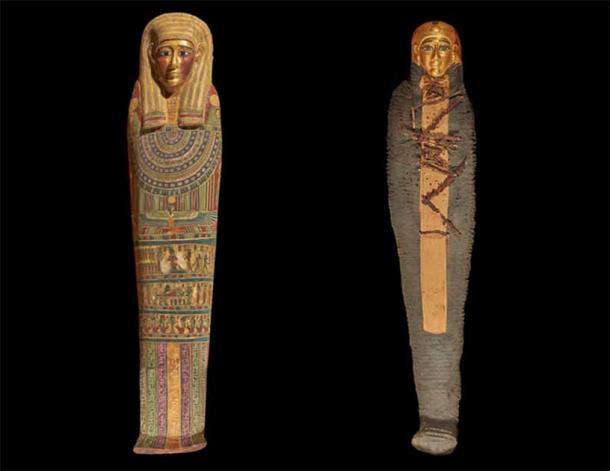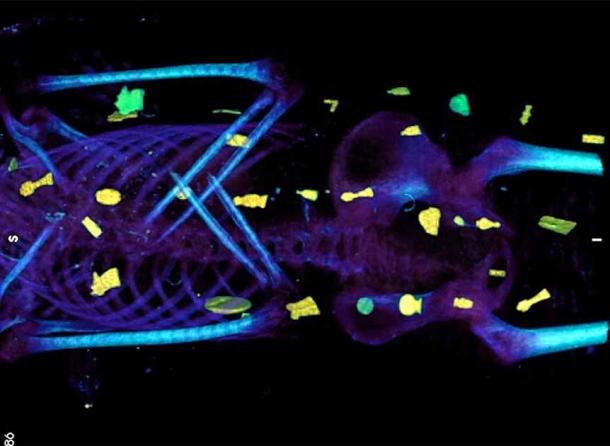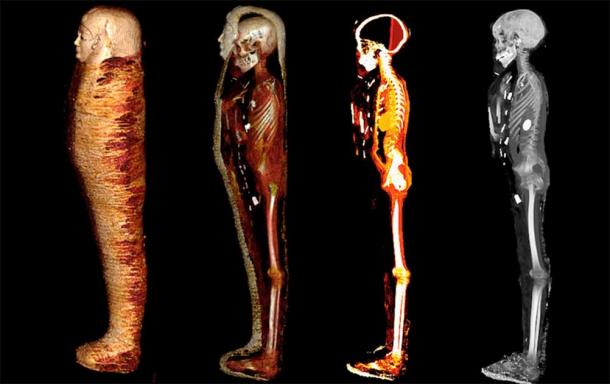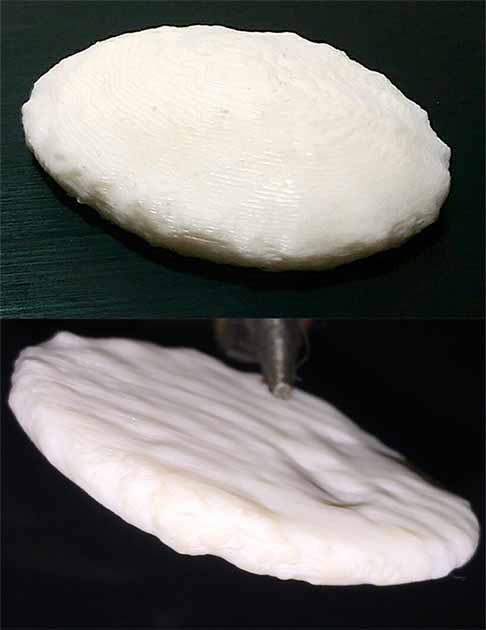
Scans Reveal Magic Amulets Inside Egyptian Golden Boy Mummy
CT scans conducted during a recent study of the “Golden Boy” mummy, which was discovered in 1916 in southern Egypt, has revealed a hidden collection of 49 magical amulets, including many forged in gold. It is believed the amulets were “strategically” placed on the mummy's body to “vitalize the dead body.”
The ancient Egyptians believed amulets, figurines, and charms held powerful supernatural energies, offering protection for both the living and the dead. As such, amulets were deposited on or inside bodies during mummification, which is exactly what happened in the case of the 2,300-year-old Golden Boy mummy.

The outer coffin of the Golden Boy mummy on the left and inner wooden sarcophagus on the right, which shows that the boy was draped with a garland of ferns and wore a gold gilded face mask. (Saleem, Seddik and el-Halwagy / CC BY 4.0)
Death Strategies in Ancient Egypt
Laid to rest inside two coffins, an outer coffin inscribed with Greek texts and an inner wooden sarcophagus, the Golden Boy earned his nickname because a fabulous gilded head mask was found in the mummy's sarcophagus. And because the deceased’s wisdom teeth had not yet emerged, researchers know the person was about 14 or 15 years old when he died.
- Mummies Scanned to Unravel the Beautiful Mysteries Bound Inside
- Woking the Dead: British Museum Bans the Word ‘Mummy’ for Ancient Remains
After its discovery in Nag el-Hassay in southern Egypt, the mummy was stored in the basement of the Egyptian Museum in Cairo without further inspection where it has remained ever since. Now, lead author of a new study Dr. Sahar Saleem, a professor of radiology at the Faculty of Medicine in Cairo University, has taken high resolution computed tomography scans, known as CT scans, of the mummy. The researcher has revealed 21 amulets in different styles, shapes and sizes placed strategically in and around the Golden Boy mummy.

CT scans revealed a number of amulets, many of them made of gold, within the mummified remains known as the Golden Boy mummy. (Saleem, Seddik and el-Halwagy / CC BY 4.0)
Prepped for the Afterlife with a Golden Tongue
The new study published in Frontiers in Medicine explained that the boy was discovered wearing a pair of sandals with a garland of ferns draped across his body. A two-finger amulet was discovered next to the boy’s uncircumcised penis, and the boy’s tongue was capped in gold.
While the boy’s identity is not clear, the vast collection of luxury grave goods discovered by the CT scans indicate that he was born into a family of high socio-economic status. According to EurekAlert!, the researcher concluded that this mummy served as a “showcase of Egyptian beliefs about death and the afterlife” during the Greek ruled Ptolemaic period which lasted from 305 BC to 30 BC.

A series of images from the study, including CT scans that "digitally unwrapped" the Golden Boy mummy. Source: Saleem, Seddik and el-Halwagy / CC BY 4.0
The Human Soul Vs the Goddess’s Feather
Ancient Egyptian cultures believed that different stones, metals, and crystals provided essential life energies and that they affected the body in various ways. But amulets also served functional roles in the afterlife. Thus, the tongue of the teenage Golden Boy was capped in gold, “to ensure the deceased could speak in the afterlife,” and his sandals allowed him “to enable the deceased to walk and leave the tomb in the afterlife,” according to the Frontiers in Medicine study.
Out of all of the artifacts identified by the CT scan, a golden heart scarab amulet found inside the boy’s torso cavity stood out to Dr. Saleem. The heart scarab is mentioned in a specific chapter of the ancient Egyptian Book of the Dead and it was considered important for the soul’s journey in the afterlife.
This particular magical device was needed during the judging of the deceased, when the heart was weighed against a goddess's feather. Specifically, it prevented the deceased’s heart from speaking during judgment, therefore, it was placed inside the torso during mummification as a replacement for the heart.

As part of the study, the team 3D printed a golden heart scarab amulet which they discovered inside the torso of the Golden boy mummy. For the ancient Egyptians, this artifact was important for the soul’s journey into the afterlife. (Saleem, Seddik and el-Halwagy / CC BY 4.0)
3D Printing Ancient Artifacts
Dr. Saleem said this particular scarab was engraved with spells on its back, created by priests to protect the boy during his journey in the afterlife. And so fascinated was the researcher with this single piece that she used a 3D printer to recreate it. Saleem told Live Science it was “really amazing” to hold the ancient design in her hands.
- Ready for the Afterlife: The Mummification Process in Ancient Egypt
- Disrespect and Desecration at Victorian Mummy Unwrapping Parties
Previous studies of the Golden Boy mummy, and the latest discovery of the hidden trove of amulets, have provided valuable new insights into ancient Egyptian ideas surrounding death and the afterlife. The amulets were placed on and around the mummy to protect the boy in the afterlife, and this new study provides valuable information about the socio-economic status of the mummy, and how elite Egyptians prepared for death and rebirth.
Resulting from these new findings, the Golden Boy mummy has been moved to the main exhibition hall at the Egyptian Museum in Cairo where it can be viewed alongside the CT images and a 3D printed version of the heart scarab amulet.
Top image: CT images of the mummy revealed amulets were placed on or inside the mummified body of the Golden Boy mummy, including a two-finger amulet discovered next to the boy’s uncircumcised penis. (Saleem, Seddik and el-Halwagy / CC BY 4.0)
By Ashley Cowie
















Comments
I thought that the word 'mummy' was banned. Or what I should do? My first language is not english but 'mummified remains' sounds nicer to me. Softer and more respectful towards ancient person.
“…amulets were deposited on or inside bodies during mummification, which is exactly what happened in the case of the 2,300-year-old Golden Boy mummy."
Exactly? Really?
Nobody gets paid to tell the truth.